Analyzing Business Law: Organizational Structures & IOM Solutions
VerifiedAdded on 2023/06/07
|8
|2493
|216
Report
AI Summary
This report examines business law in the UK, focusing on various organizational structures such as sole proprietorships, general partnerships, limited liability partnerships, and limited liability companies. It discusses the legal and tax implications of each structure, highlighting the advantages and disadvantages. The report also addresses the rights and responsibilities of employers and employees under UK law, including vicarious liability and negligence. Furthermore, it provides a recommendation for IOM Solutions, suggesting a transition from a sole proprietorship to a Limited Liability Company to facilitate business growth and reduce personal liability. Desklib offers a wealth of resources, including past papers and solved assignments, for students studying business law.
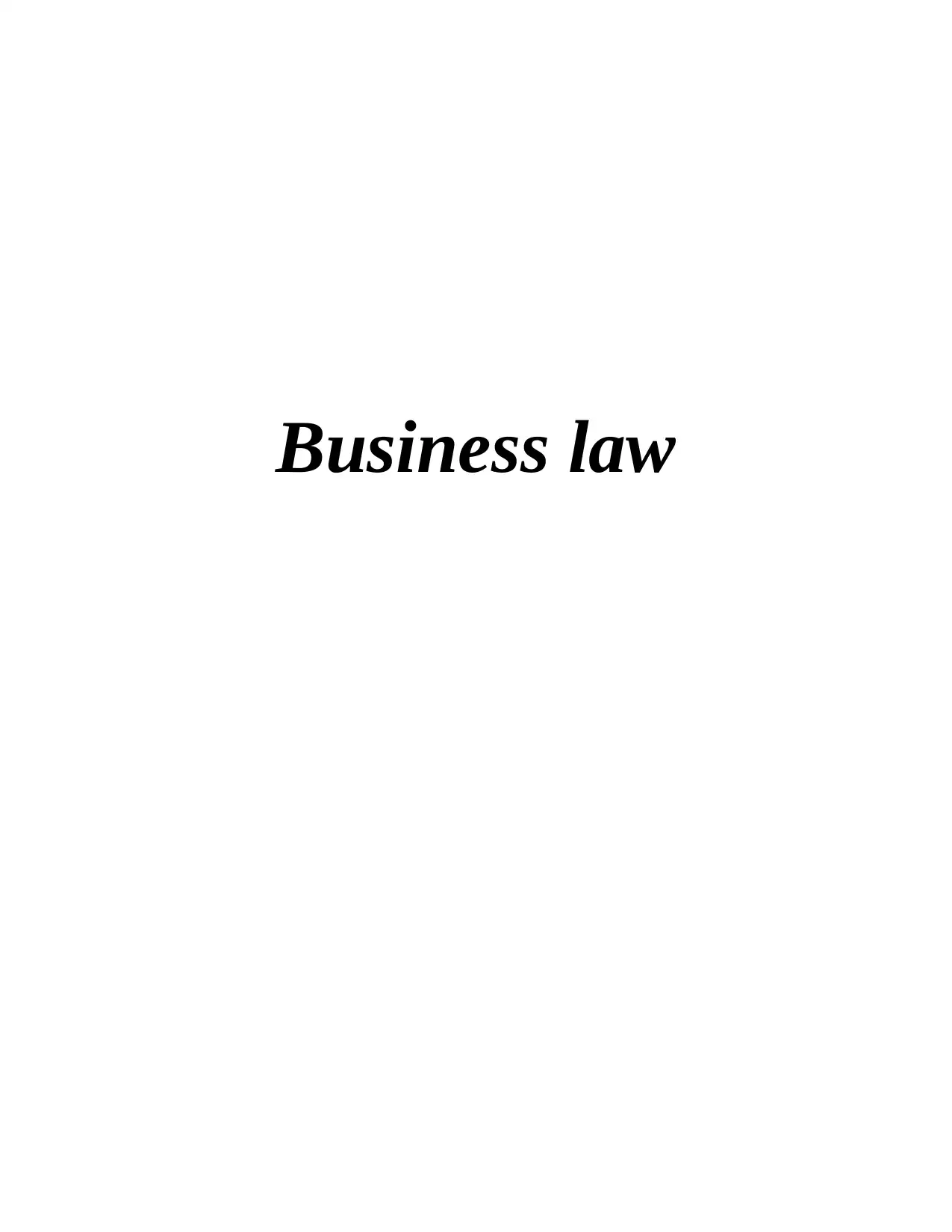
Business law
Paraphrase This Document
Need a fresh take? Get an instant paraphrase of this document with our AI Paraphraser
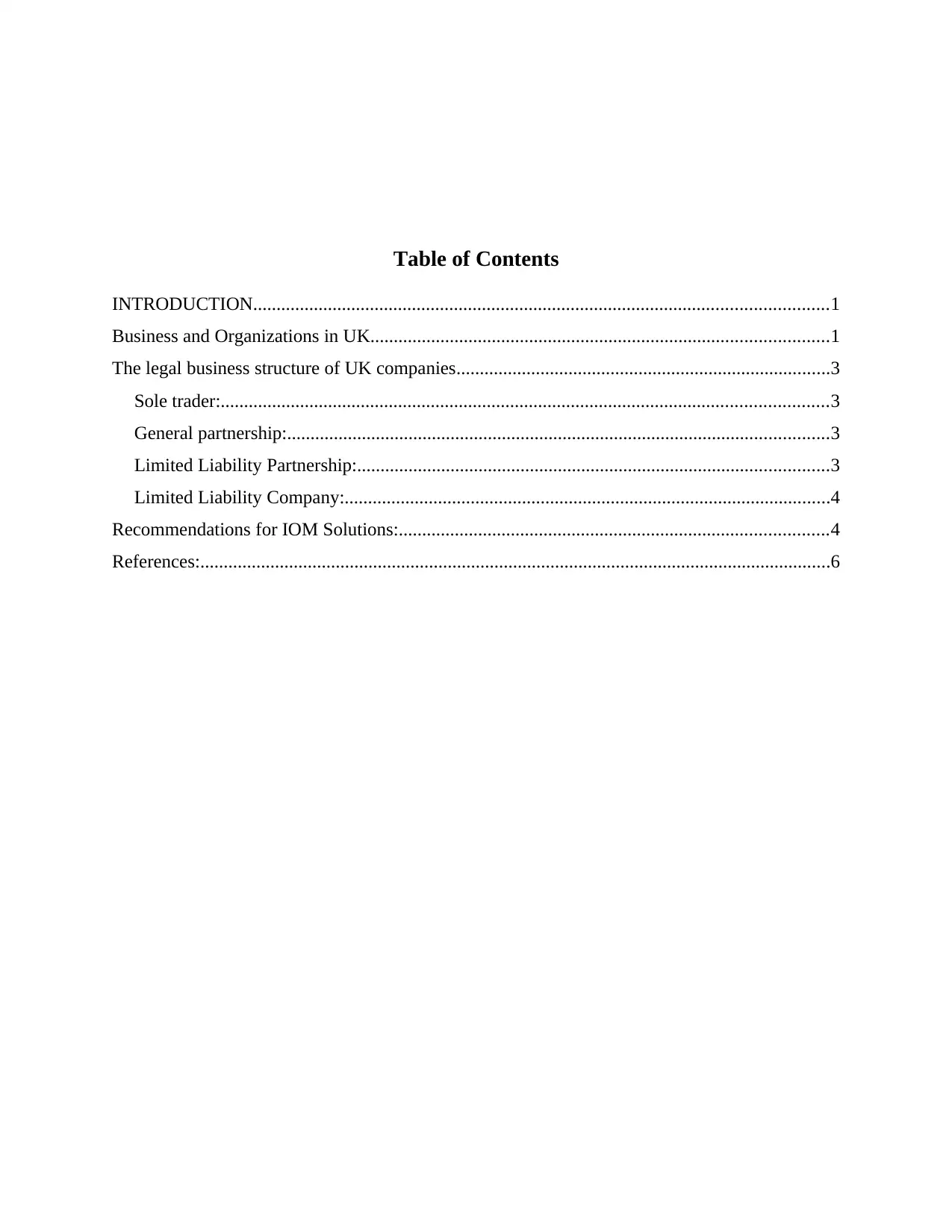
Table of Contents
INTRODUCTION...........................................................................................................................1
Business and Organizations in UK..................................................................................................1
The legal business structure of UK companies................................................................................3
Sole trader:..................................................................................................................................3
General partnership:....................................................................................................................3
Limited Liability Partnership:.....................................................................................................3
Limited Liability Company:........................................................................................................4
Recommendations for IOM Solutions:............................................................................................4
References:.......................................................................................................................................6
INTRODUCTION...........................................................................................................................1
Business and Organizations in UK..................................................................................................1
The legal business structure of UK companies................................................................................3
Sole trader:..................................................................................................................................3
General partnership:....................................................................................................................3
Limited Liability Partnership:.....................................................................................................3
Limited Liability Company:........................................................................................................4
Recommendations for IOM Solutions:............................................................................................4
References:.......................................................................................................................................6
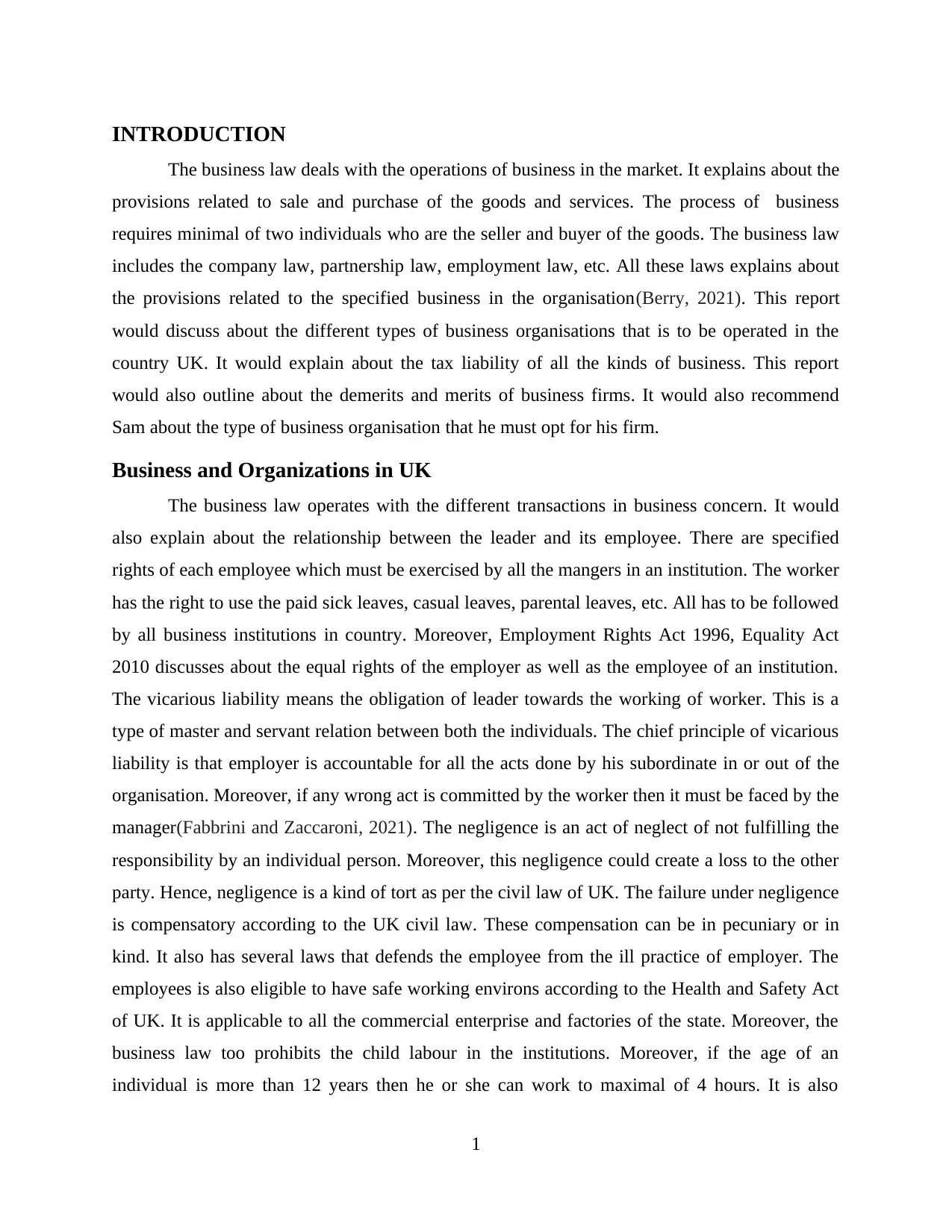
INTRODUCTION
The business law deals with the operations of business in the market. It explains about the
provisions related to sale and purchase of the goods and services. The process of business
requires minimal of two individuals who are the seller and buyer of the goods. The business law
includes the company law, partnership law, employment law, etc. All these laws explains about
the provisions related to the specified business in the organisation(Berry, 2021). This report
would discuss about the different types of business organisations that is to be operated in the
country UK. It would explain about the tax liability of all the kinds of business. This report
would also outline about the demerits and merits of business firms. It would also recommend
Sam about the type of business organisation that he must opt for his firm.
Business and Organizations in UK
The business law operates with the different transactions in business concern. It would
also explain about the relationship between the leader and its employee. There are specified
rights of each employee which must be exercised by all the mangers in an institution. The worker
has the right to use the paid sick leaves, casual leaves, parental leaves, etc. All has to be followed
by all business institutions in country. Moreover, Employment Rights Act 1996, Equality Act
2010 discusses about the equal rights of the employer as well as the employee of an institution.
The vicarious liability means the obligation of leader towards the working of worker. This is a
type of master and servant relation between both the individuals. The chief principle of vicarious
liability is that employer is accountable for all the acts done by his subordinate in or out of the
organisation. Moreover, if any wrong act is committed by the worker then it must be faced by the
manager(Fabbrini and Zaccaroni, 2021). The negligence is an act of neglect of not fulfilling the
responsibility by an individual person. Moreover, this negligence could create a loss to the other
party. Hence, negligence is a kind of tort as per the civil law of UK. The failure under negligence
is compensatory according to the UK civil law. These compensation can be in pecuniary or in
kind. It also has several laws that defends the employee from the ill practice of employer. The
employees is also eligible to have safe working environs according to the Health and Safety Act
of UK. It is applicable to all the commercial enterprise and factories of the state. Moreover, the
business law too prohibits the child labour in the institutions. Moreover, if the age of an
individual is more than 12 years then he or she can work to maximal of 4 hours. It is also
1
The business law deals with the operations of business in the market. It explains about the
provisions related to sale and purchase of the goods and services. The process of business
requires minimal of two individuals who are the seller and buyer of the goods. The business law
includes the company law, partnership law, employment law, etc. All these laws explains about
the provisions related to the specified business in the organisation(Berry, 2021). This report
would discuss about the different types of business organisations that is to be operated in the
country UK. It would explain about the tax liability of all the kinds of business. This report
would also outline about the demerits and merits of business firms. It would also recommend
Sam about the type of business organisation that he must opt for his firm.
Business and Organizations in UK
The business law operates with the different transactions in business concern. It would
also explain about the relationship between the leader and its employee. There are specified
rights of each employee which must be exercised by all the mangers in an institution. The worker
has the right to use the paid sick leaves, casual leaves, parental leaves, etc. All has to be followed
by all business institutions in country. Moreover, Employment Rights Act 1996, Equality Act
2010 discusses about the equal rights of the employer as well as the employee of an institution.
The vicarious liability means the obligation of leader towards the working of worker. This is a
type of master and servant relation between both the individuals. The chief principle of vicarious
liability is that employer is accountable for all the acts done by his subordinate in or out of the
organisation. Moreover, if any wrong act is committed by the worker then it must be faced by the
manager(Fabbrini and Zaccaroni, 2021). The negligence is an act of neglect of not fulfilling the
responsibility by an individual person. Moreover, this negligence could create a loss to the other
party. Hence, negligence is a kind of tort as per the civil law of UK. The failure under negligence
is compensatory according to the UK civil law. These compensation can be in pecuniary or in
kind. It also has several laws that defends the employee from the ill practice of employer. The
employees is also eligible to have safe working environs according to the Health and Safety Act
of UK. It is applicable to all the commercial enterprise and factories of the state. Moreover, the
business law too prohibits the child labour in the institutions. Moreover, if the age of an
individual is more than 12 years then he or she can work to maximal of 4 hours. It is also
1
⊘ This is a preview!⊘
Do you want full access?
Subscribe today to unlock all pages.

Trusted by 1+ million students worldwide
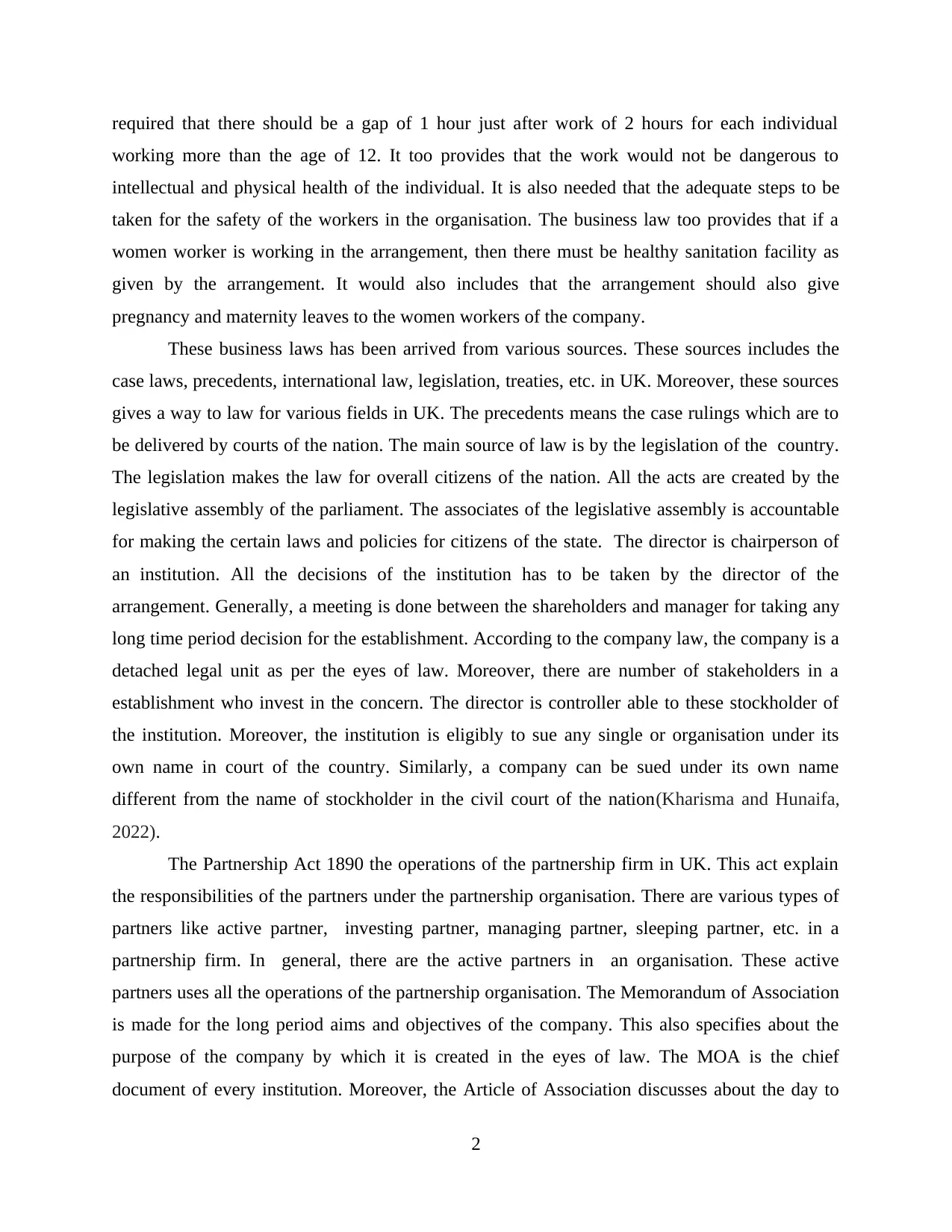
required that there should be a gap of 1 hour just after work of 2 hours for each individual
working more than the age of 12. It too provides that the work would not be dangerous to
intellectual and physical health of the individual. It is also needed that the adequate steps to be
taken for the safety of the workers in the organisation. The business law too provides that if a
women worker is working in the arrangement, then there must be healthy sanitation facility as
given by the arrangement. It would also includes that the arrangement should also give
pregnancy and maternity leaves to the women workers of the company.
These business laws has been arrived from various sources. These sources includes the
case laws, precedents, international law, legislation, treaties, etc. in UK. Moreover, these sources
gives a way to law for various fields in UK. The precedents means the case rulings which are to
be delivered by courts of the nation. The main source of law is by the legislation of the country.
The legislation makes the law for overall citizens of the nation. All the acts are created by the
legislative assembly of the parliament. The associates of the legislative assembly is accountable
for making the certain laws and policies for citizens of the state. The director is chairperson of
an institution. All the decisions of the institution has to be taken by the director of the
arrangement. Generally, a meeting is done between the shareholders and manager for taking any
long time period decision for the establishment. According to the company law, the company is a
detached legal unit as per the eyes of law. Moreover, there are number of stakeholders in a
establishment who invest in the concern. The director is controller able to these stockholder of
the institution. Moreover, the institution is eligibly to sue any single or organisation under its
own name in court of the country. Similarly, a company can be sued under its own name
different from the name of stockholder in the civil court of the nation(Kharisma and Hunaifa,
2022).
The Partnership Act 1890 the operations of the partnership firm in UK. This act explain
the responsibilities of the partners under the partnership organisation. There are various types of
partners like active partner, investing partner, managing partner, sleeping partner, etc. in a
partnership firm. In general, there are the active partners in an organisation. These active
partners uses all the operations of the partnership organisation. The Memorandum of Association
is made for the long period aims and objectives of the company. This also specifies about the
purpose of the company by which it is created in the eyes of law. The MOA is the chief
document of every institution. Moreover, the Article of Association discusses about the day to
2
working more than the age of 12. It too provides that the work would not be dangerous to
intellectual and physical health of the individual. It is also needed that the adequate steps to be
taken for the safety of the workers in the organisation. The business law too provides that if a
women worker is working in the arrangement, then there must be healthy sanitation facility as
given by the arrangement. It would also includes that the arrangement should also give
pregnancy and maternity leaves to the women workers of the company.
These business laws has been arrived from various sources. These sources includes the
case laws, precedents, international law, legislation, treaties, etc. in UK. Moreover, these sources
gives a way to law for various fields in UK. The precedents means the case rulings which are to
be delivered by courts of the nation. The main source of law is by the legislation of the country.
The legislation makes the law for overall citizens of the nation. All the acts are created by the
legislative assembly of the parliament. The associates of the legislative assembly is accountable
for making the certain laws and policies for citizens of the state. The director is chairperson of
an institution. All the decisions of the institution has to be taken by the director of the
arrangement. Generally, a meeting is done between the shareholders and manager for taking any
long time period decision for the establishment. According to the company law, the company is a
detached legal unit as per the eyes of law. Moreover, there are number of stakeholders in a
establishment who invest in the concern. The director is controller able to these stockholder of
the institution. Moreover, the institution is eligibly to sue any single or organisation under its
own name in court of the country. Similarly, a company can be sued under its own name
different from the name of stockholder in the civil court of the nation(Kharisma and Hunaifa,
2022).
The Partnership Act 1890 the operations of the partnership firm in UK. This act explain
the responsibilities of the partners under the partnership organisation. There are various types of
partners like active partner, investing partner, managing partner, sleeping partner, etc. in a
partnership firm. In general, there are the active partners in an organisation. These active
partners uses all the operations of the partnership organisation. The Memorandum of Association
is made for the long period aims and objectives of the company. This also specifies about the
purpose of the company by which it is created in the eyes of law. The MOA is the chief
document of every institution. Moreover, the Article of Association discusses about the day to
2
Paraphrase This Document
Need a fresh take? Get an instant paraphrase of this document with our AI Paraphraser
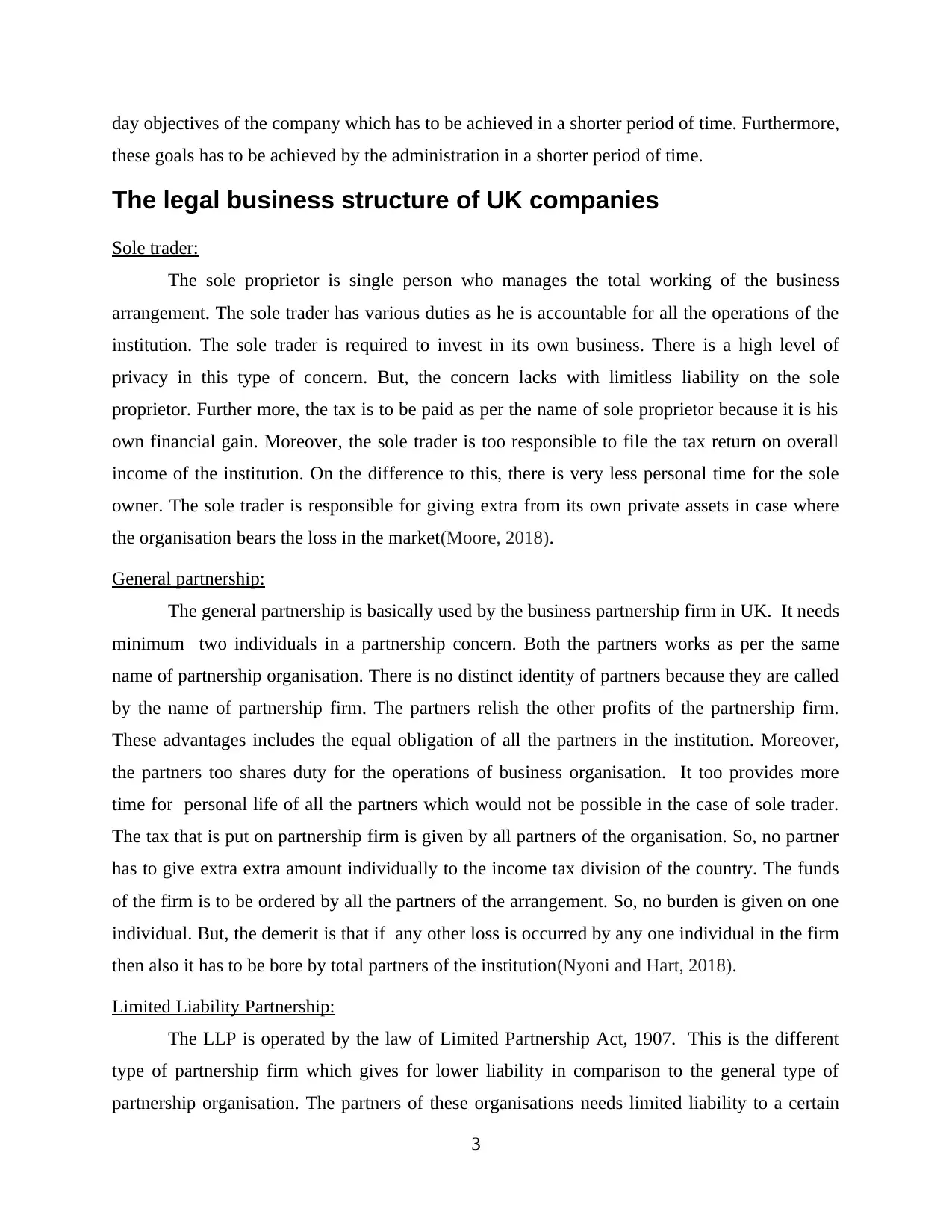
day objectives of the company which has to be achieved in a shorter period of time. Furthermore,
these goals has to be achieved by the administration in a shorter period of time.
The legal business structure of UK companies
Sole trader:
The sole proprietor is single person who manages the total working of the business
arrangement. The sole trader has various duties as he is accountable for all the operations of the
institution. The sole trader is required to invest in its own business. There is a high level of
privacy in this type of concern. But, the concern lacks with limitless liability on the sole
proprietor. Further more, the tax is to be paid as per the name of sole proprietor because it is his
own financial gain. Moreover, the sole trader is too responsible to file the tax return on overall
income of the institution. On the difference to this, there is very less personal time for the sole
owner. The sole trader is responsible for giving extra from its own private assets in case where
the organisation bears the loss in the market(Moore, 2018).
General partnership:
The general partnership is basically used by the business partnership firm in UK. It needs
minimum two individuals in a partnership concern. Both the partners works as per the same
name of partnership organisation. There is no distinct identity of partners because they are called
by the name of partnership firm. The partners relish the other profits of the partnership firm.
These advantages includes the equal obligation of all the partners in the institution. Moreover,
the partners too shares duty for the operations of business organisation. It too provides more
time for personal life of all the partners which would not be possible in the case of sole trader.
The tax that is put on partnership firm is given by all partners of the organisation. So, no partner
has to give extra extra amount individually to the income tax division of the country. The funds
of the firm is to be ordered by all the partners of the arrangement. So, no burden is given on one
individual. But, the demerit is that if any other loss is occurred by any one individual in the firm
then also it has to be bore by total partners of the institution(Nyoni and Hart, 2018).
Limited Liability Partnership:
The LLP is operated by the law of Limited Partnership Act, 1907. This is the different
type of partnership firm which gives for lower liability in comparison to the general type of
partnership organisation. The partners of these organisations needs limited liability to a certain
3
these goals has to be achieved by the administration in a shorter period of time.
The legal business structure of UK companies
Sole trader:
The sole proprietor is single person who manages the total working of the business
arrangement. The sole trader has various duties as he is accountable for all the operations of the
institution. The sole trader is required to invest in its own business. There is a high level of
privacy in this type of concern. But, the concern lacks with limitless liability on the sole
proprietor. Further more, the tax is to be paid as per the name of sole proprietor because it is his
own financial gain. Moreover, the sole trader is too responsible to file the tax return on overall
income of the institution. On the difference to this, there is very less personal time for the sole
owner. The sole trader is responsible for giving extra from its own private assets in case where
the organisation bears the loss in the market(Moore, 2018).
General partnership:
The general partnership is basically used by the business partnership firm in UK. It needs
minimum two individuals in a partnership concern. Both the partners works as per the same
name of partnership organisation. There is no distinct identity of partners because they are called
by the name of partnership firm. The partners relish the other profits of the partnership firm.
These advantages includes the equal obligation of all the partners in the institution. Moreover,
the partners too shares duty for the operations of business organisation. It too provides more
time for personal life of all the partners which would not be possible in the case of sole trader.
The tax that is put on partnership firm is given by all partners of the organisation. So, no partner
has to give extra extra amount individually to the income tax division of the country. The funds
of the firm is to be ordered by all the partners of the arrangement. So, no burden is given on one
individual. But, the demerit is that if any other loss is occurred by any one individual in the firm
then also it has to be bore by total partners of the institution(Nyoni and Hart, 2018).
Limited Liability Partnership:
The LLP is operated by the law of Limited Partnership Act, 1907. This is the different
type of partnership firm which gives for lower liability in comparison to the general type of
partnership organisation. The partners of these organisations needs limited liability to a certain
3
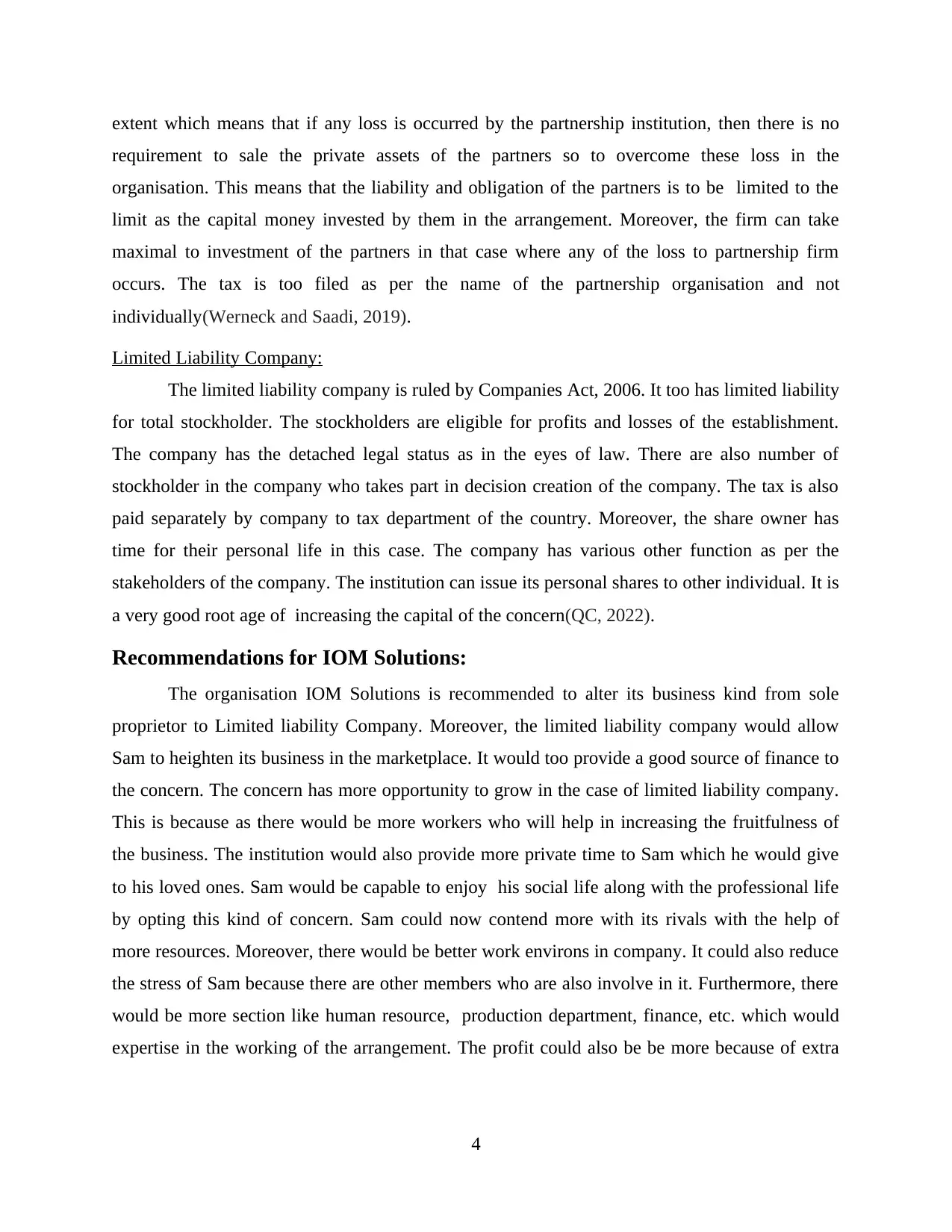
extent which means that if any loss is occurred by the partnership institution, then there is no
requirement to sale the private assets of the partners so to overcome these loss in the
organisation. This means that the liability and obligation of the partners is to be limited to the
limit as the capital money invested by them in the arrangement. Moreover, the firm can take
maximal to investment of the partners in that case where any of the loss to partnership firm
occurs. The tax is too filed as per the name of the partnership organisation and not
individually(Werneck and Saadi, 2019).
Limited Liability Company:
The limited liability company is ruled by Companies Act, 2006. It too has limited liability
for total stockholder. The stockholders are eligible for profits and losses of the establishment.
The company has the detached legal status as in the eyes of law. There are also number of
stockholder in the company who takes part in decision creation of the company. The tax is also
paid separately by company to tax department of the country. Moreover, the share owner has
time for their personal life in this case. The company has various other function as per the
stakeholders of the company. The institution can issue its personal shares to other individual. It is
a very good root age of increasing the capital of the concern(QC, 2022).
Recommendations for IOM Solutions:
The organisation IOM Solutions is recommended to alter its business kind from sole
proprietor to Limited liability Company. Moreover, the limited liability company would allow
Sam to heighten its business in the marketplace. It would too provide a good source of finance to
the concern. The concern has more opportunity to grow in the case of limited liability company.
This is because as there would be more workers who will help in increasing the fruitfulness of
the business. The institution would also provide more private time to Sam which he would give
to his loved ones. Sam would be capable to enjoy his social life along with the professional life
by opting this kind of concern. Sam could now contend more with its rivals with the help of
more resources. Moreover, there would be better work environs in company. It could also reduce
the stress of Sam because there are other members who are also involve in it. Furthermore, there
would be more section like human resource, production department, finance, etc. which would
expertise in the working of the arrangement. The profit could also be be more because of extra
4
requirement to sale the private assets of the partners so to overcome these loss in the
organisation. This means that the liability and obligation of the partners is to be limited to the
limit as the capital money invested by them in the arrangement. Moreover, the firm can take
maximal to investment of the partners in that case where any of the loss to partnership firm
occurs. The tax is too filed as per the name of the partnership organisation and not
individually(Werneck and Saadi, 2019).
Limited Liability Company:
The limited liability company is ruled by Companies Act, 2006. It too has limited liability
for total stockholder. The stockholders are eligible for profits and losses of the establishment.
The company has the detached legal status as in the eyes of law. There are also number of
stockholder in the company who takes part in decision creation of the company. The tax is also
paid separately by company to tax department of the country. Moreover, the share owner has
time for their personal life in this case. The company has various other function as per the
stakeholders of the company. The institution can issue its personal shares to other individual. It is
a very good root age of increasing the capital of the concern(QC, 2022).
Recommendations for IOM Solutions:
The organisation IOM Solutions is recommended to alter its business kind from sole
proprietor to Limited liability Company. Moreover, the limited liability company would allow
Sam to heighten its business in the marketplace. It would too provide a good source of finance to
the concern. The concern has more opportunity to grow in the case of limited liability company.
This is because as there would be more workers who will help in increasing the fruitfulness of
the business. The institution would also provide more private time to Sam which he would give
to his loved ones. Sam would be capable to enjoy his social life along with the professional life
by opting this kind of concern. Sam could now contend more with its rivals with the help of
more resources. Moreover, there would be better work environs in company. It could also reduce
the stress of Sam because there are other members who are also involve in it. Furthermore, there
would be more section like human resource, production department, finance, etc. which would
expertise in the working of the arrangement. The profit could also be be more because of extra
4
⊘ This is a preview!⊘
Do you want full access?
Subscribe today to unlock all pages.

Trusted by 1+ million students worldwide
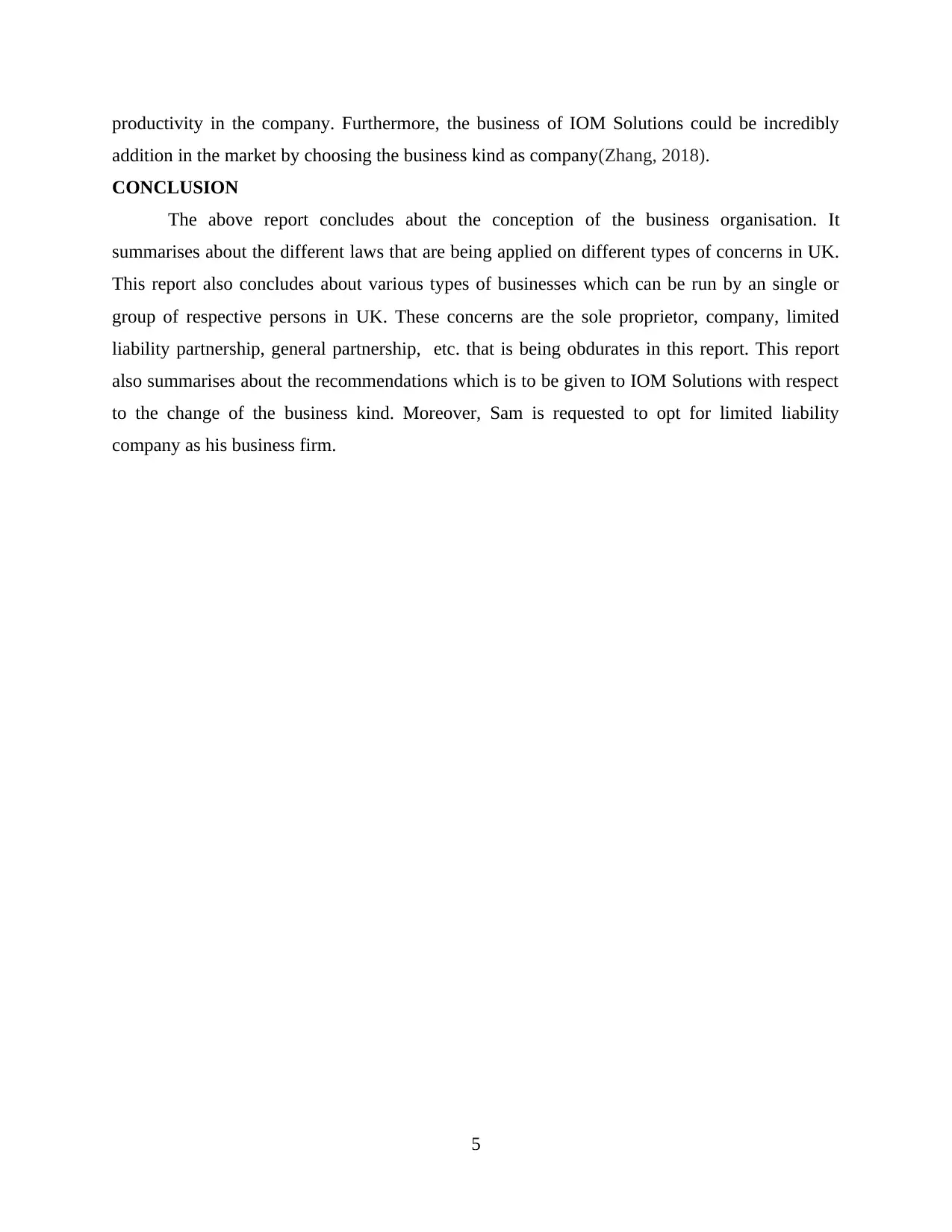
productivity in the company. Furthermore, the business of IOM Solutions could be incredibly
addition in the market by choosing the business kind as company(Zhang, 2018).
CONCLUSION
The above report concludes about the conception of the business organisation. It
summarises about the different laws that are being applied on different types of concerns in UK.
This report also concludes about various types of businesses which can be run by an single or
group of respective persons in UK. These concerns are the sole proprietor, company, limited
liability partnership, general partnership, etc. that is being obdurates in this report. This report
also summarises about the recommendations which is to be given to IOM Solutions with respect
to the change of the business kind. Moreover, Sam is requested to opt for limited liability
company as his business firm.
5
addition in the market by choosing the business kind as company(Zhang, 2018).
CONCLUSION
The above report concludes about the conception of the business organisation. It
summarises about the different laws that are being applied on different types of concerns in UK.
This report also concludes about various types of businesses which can be run by an single or
group of respective persons in UK. These concerns are the sole proprietor, company, limited
liability partnership, general partnership, etc. that is being obdurates in this report. This report
also summarises about the recommendations which is to be given to IOM Solutions with respect
to the change of the business kind. Moreover, Sam is requested to opt for limited liability
company as his business firm.
5
Paraphrase This Document
Need a fresh take? Get an instant paraphrase of this document with our AI Paraphraser
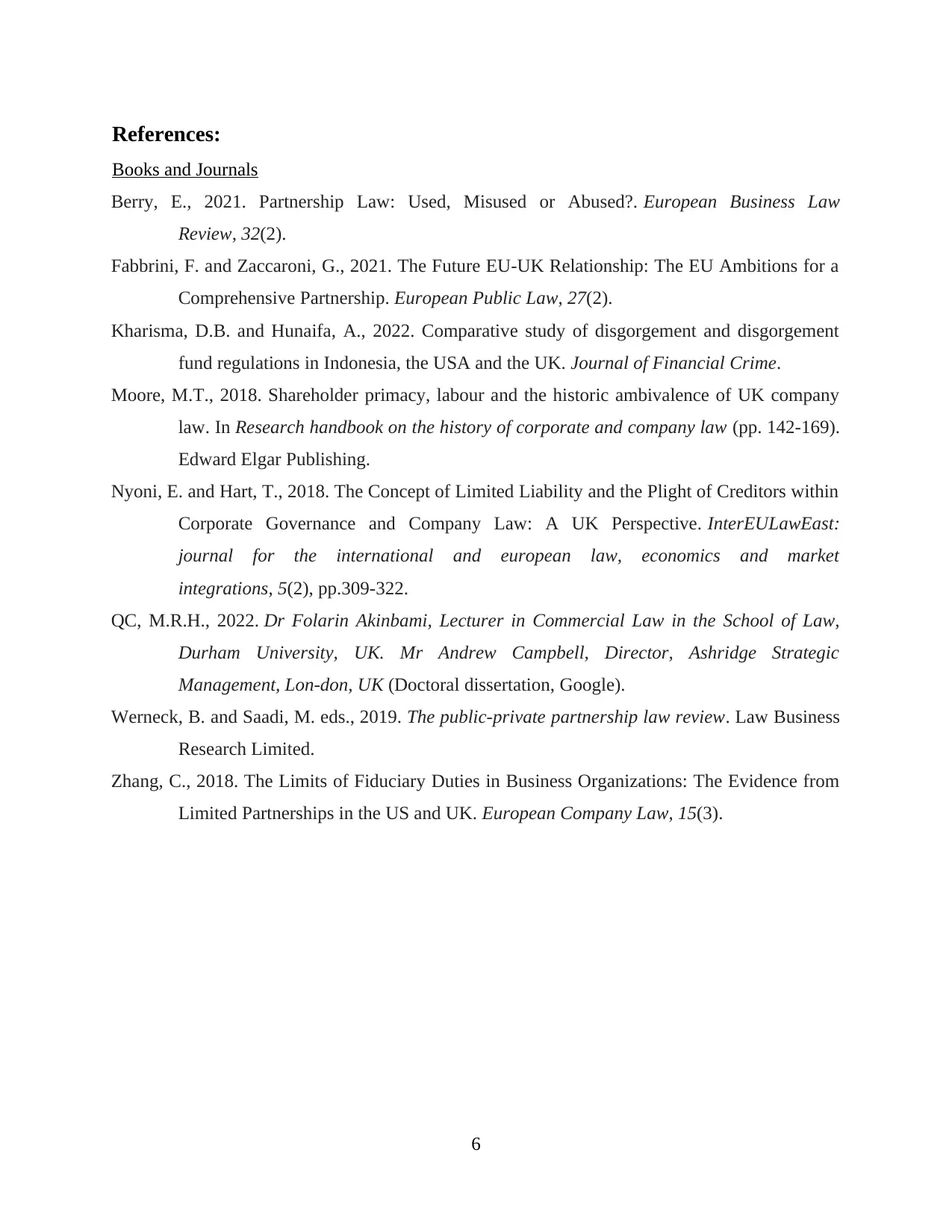
References:
Books and Journals
Berry, E., 2021. Partnership Law: Used, Misused or Abused?. European Business Law
Review, 32(2).
Fabbrini, F. and Zaccaroni, G., 2021. The Future EU-UK Relationship: The EU Ambitions for a
Comprehensive Partnership. European Public Law, 27(2).
Kharisma, D.B. and Hunaifa, A., 2022. Comparative study of disgorgement and disgorgement
fund regulations in Indonesia, the USA and the UK. Journal of Financial Crime.
Moore, M.T., 2018. Shareholder primacy, labour and the historic ambivalence of UK company
law. In Research handbook on the history of corporate and company law (pp. 142-169).
Edward Elgar Publishing.
Nyoni, E. and Hart, T., 2018. The Concept of Limited Liability and the Plight of Creditors within
Corporate Governance and Company Law: A UK Perspective. InterEULawEast:
journal for the international and european law, economics and market
integrations, 5(2), pp.309-322.
QC, M.R.H., 2022. Dr Folarin Akinbami, Lecturer in Commercial Law in the School of Law,
Durham University, UK. Mr Andrew Campbell, Director, Ashridge Strategic
Management, Lon-don, UK (Doctoral dissertation, Google).
Werneck, B. and Saadi, M. eds., 2019. The public-private partnership law review. Law Business
Research Limited.
Zhang, C., 2018. The Limits of Fiduciary Duties in Business Organizations: The Evidence from
Limited Partnerships in the US and UK. European Company Law, 15(3).
6
Books and Journals
Berry, E., 2021. Partnership Law: Used, Misused or Abused?. European Business Law
Review, 32(2).
Fabbrini, F. and Zaccaroni, G., 2021. The Future EU-UK Relationship: The EU Ambitions for a
Comprehensive Partnership. European Public Law, 27(2).
Kharisma, D.B. and Hunaifa, A., 2022. Comparative study of disgorgement and disgorgement
fund regulations in Indonesia, the USA and the UK. Journal of Financial Crime.
Moore, M.T., 2018. Shareholder primacy, labour and the historic ambivalence of UK company
law. In Research handbook on the history of corporate and company law (pp. 142-169).
Edward Elgar Publishing.
Nyoni, E. and Hart, T., 2018. The Concept of Limited Liability and the Plight of Creditors within
Corporate Governance and Company Law: A UK Perspective. InterEULawEast:
journal for the international and european law, economics and market
integrations, 5(2), pp.309-322.
QC, M.R.H., 2022. Dr Folarin Akinbami, Lecturer in Commercial Law in the School of Law,
Durham University, UK. Mr Andrew Campbell, Director, Ashridge Strategic
Management, Lon-don, UK (Doctoral dissertation, Google).
Werneck, B. and Saadi, M. eds., 2019. The public-private partnership law review. Law Business
Research Limited.
Zhang, C., 2018. The Limits of Fiduciary Duties in Business Organizations: The Evidence from
Limited Partnerships in the US and UK. European Company Law, 15(3).
6
1 out of 8
Related Documents
Your All-in-One AI-Powered Toolkit for Academic Success.
+13062052269
info@desklib.com
Available 24*7 on WhatsApp / Email
![[object Object]](/_next/static/media/star-bottom.7253800d.svg)
Unlock your academic potential
Copyright © 2020–2025 A2Z Services. All Rights Reserved. Developed and managed by ZUCOL.

